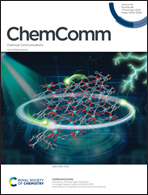Chloroplast biosolar cell and self-powered herbicide monitoring†
Abstract
Utilizing chloroplasts in biosolar cells offers a sustainable approach for sunlight harvesting. However, the limited electrochemical communication between these biological entities and an electrode surface has led to complex device setups, hindering their application in the field. Herein, a cross-linker enables a simple photoanode architecture with enhanced photoexcited electron transfer between chloroplasts and abiotic electrodes. The improved “wiring” of the photosynthetic electron transfer chain resulted in a five-fold increase in the biophotocurrent. The biophotoanode is applied in a Pt-free, portable biosolar cell allowing the in situ self-powered monitoring of diuron within limits set by the Environmental Protection Agency.



 Please wait while we load your content...
Please wait while we load your content...